-
Paper Information
- Paper Submission
-
Journal Information
- About This Journal
- Editorial Board
- Current Issue
- Archive
- Author Guidelines
- Contact Us
Education
p-ISSN: 2162-9463 e-ISSN: 2162-8467
2021; 11(1): 1-10
doi:10.5923/j.edu.20211101.01
Received: Dec. 14, 2020; Accepted: Jan. 10, 2021; Published: Jan. 25, 2021

Future Direction of Global Educational Hackathons- A Critical Evaluation Based on Feedbacks of a Global Hackathon on Digital Education - Sri Lanka Perspective
Ruchira Abeyweera1, Iresha U. Attanayake1, U. G. Kithsiri1, Nihal S. Senanayake1, Torsten H. Fransson2
1Department of Mechanical Engineering, The Open University of Sri Lanka, Nugegoda
2Formerly Educational Strategic Advisor, EIT InnoEnergy, Prof em – Royal Institute of Technology (KTH), Stockholm, Sweden
Correspondence to: Nihal S. Senanayake, Department of Mechanical Engineering, The Open University of Sri Lanka, Nugegoda.
| Email: |  |
Copyright © 2021 The Author(s). Published by Scientific & Academic Publishing.
This work is licensed under the Creative Commons Attribution International License (CC BY).
http://creativecommons.org/licenses/by/4.0/

Hackathons can play a vital role in discovering feasible solutions to the issues in the very dynamic field of education, especially the higher education. The demand for higher educational opportunities is increasing globally and providing access to high quality educational opportunities for all with the existing pedagogies is becoming a serious issue, especially for emerging economies. This study focuses on a hackathon, named as DigiEduHack’19 conducted recently. DigiEduHack is an initiative of European Institute of Innovation & Technology (EIT) under the European Commission’s Digital Education Action Plan, led by EIT Climate- Knowledge Innovation Community and coordinated by Aalto University. This paper investigates the insight of the event organized in Sri Lanka as a participating country of the global DigiEduHack’19, focusing on the process of organization of the event and how the participants reflected on the different aspects of the hackathon, in the context that Sri Lanka has little experience of this type events. Nearly 90% had right understanding on the purpose of their taking part in the event. About the source of getting to know about the event, the social media was found to be most effective. Thirty six percent of the participants indicated that the event was of the type they expected, whereas 14% indicated that the event was completely different to that they expected. With regard time duration of the event, 69% were found to be satisfied whereas 30% were of the view that duration is too long. A majority (84%) were found to be satisfied as being partners to the event after seeing the other groups’ solutions in the final stage. Many of the participants voted for “learning novel concepts” as being the most excited about the event. The most troubling about the event was the short time given for the participants to present their solutions to the audience and evaluators. In addition, working until midnight, time duration, environmental condition, rest time periods, and rest rooms were indicated as of the most concerned. All these are related to logistic and organization of the event. No serious comments were given for technical assistance, mentoring and other academic support given to the participants. The most important outcomes of the event were that inspiration created among all that will be a stimulus to create similar actions to seek speedy solutions to the problems in the digital education arena, the experiences gained, and the lessons learnt.
Keywords: Hackathon, Digital education, Sri Lanka
Cite this paper: Ruchira Abeyweera, Iresha U. Attanayake, U. G. Kithsiri, Nihal S. Senanayake, Torsten H. Fransson, Future Direction of Global Educational Hackathons- A Critical Evaluation Based on Feedbacks of a Global Hackathon on Digital Education - Sri Lanka Perspective, Education, Vol. 11 No. 1, 2021, pp. 1-10. doi: 10.5923/j.edu.20211101.01.
Article Outline
1. Introduction
- Hackathon is a well-planned event in which a gathering of people use technology to hack into a real-world problem to solve them within a specified time lasting 24 – 72 hours. The participants and stakeholders argue deeply into solving challenges. Main important component of this process is to learn as much as you can gain during the short time. This is an extraordinary event for the participant since hackathons do not know the clear direction of targeted scope of work before entering as well as not knowing required extra details to complete the work [1]. In recent years, hackathons have evolved, transitioning from a stereotypical computer programming and software innovations into a variety of industries. Today there are hackathons for medical technology, lifestyle apps, social media innovation, and important social issues -- and the list is continually growing.Nevertheless, hackathons last for 1 – 3 days of continuous engagement in challenges, they must be well planned to involve several main steps which need considerable time and effort. These include defining challenges and goals, identifying attendees, setting clear rules, identifying venue with facilities including internet access for all attendees, procedure of selecting the best solutions, and identification of judges in relevant subject area having experience in similar tasks. The developments in the use of the electronic media have influenced all walks of life. Education is no exception to this. The use of computers and the internet for enhancing the quality of education by making learning more relevant to life has been an ideal by educational institutions [2]. The use of modern equipment technology and tools increases the learning and interactivity of students [3]. With the fast expansion of the use of digital platforms for education into many diverse groups and purposes, more and more issues are coming up that must be researched on and provide solutions. Hackathons provide an appropriate way to quickly take up the challenges and gain further insight into them with wider participation and innovative approaches of wider community in education technology arena. Hackathons at higher education institutional levels have been developed since early 2000 and have recently been growing rapidly. These hackathons are often handled by students with minimal institutional support [4].Hackathons exist on the principle that participants will self-motivate and extend significant contribution through planned communications [5]. But extrinsic motivation will certainly lead to live and enthusiastic engagement towards determining the most innovative solutions. One of the most important aspects of a hackathon is the evaluation of innovative solutions proposed by participating groups which leads to a competition that in turn motivate the participants to deliver the best solutions finally contributing to provide brilliant solutions to the problems posed by the organizers. The participants in the hackathon in this paper were mainly students and the young graduates in the field of engineering and science, and they were extremely motivated in innovations. Success of hackathons depend on the perception and insight of participants in different aspects of entire process in which the organizers of the event have great responsibility. The conditions that are not encouraging for the participants to engage in productive and critical thinking will deter the enthusiasm.In this paper, we describe the outcomes and evaluation of important aspects of a global hackathon that would impact on the intended purposes based on feedback of participants as well as information collected from the organizers and their observations about the facilitation of the event. The specific event selected for the critical look at different aspects was educational hackathon called DigiEduHack’191 coordinated by the Open University of Sri Lanka with the European Union, Aalto University and EIT Climate – KIC2.DigiEduHack is an initiative of European Institute of Innovation & Technology (EIT) under the European Commission’s Digital Education Action Plan, led by EIT Climate- Knowledge Innovation Community (KIC) and coordinated by Aalto University. The main intention of DigiEduHack is to promote and strengthen synergies and cooperation among educational institutions, research organizations and businesses, while furthering inclusiveness in the educational field. Another goal is to engage educational stakeholders in a dialogue on the future of education in a digital age and make their voice heard.
2. Importance of Digital Education
- Information Technology supported education has been a topic for wide discussion among teachers and students in the last few decades. The term Digital education refers to the use of digital tools and technologies in learning and teaching process, sometimes it is called e-learning and is essentially a remote education. There are many benefits from digital education one of them being the chance to learn with flexible time. Hence, the students can engage in various other activities like employment and studying other subject areas which are unique to each student. However, the view that digital technologies in education has a positive impact on learning has been questioned by some experts [6]. Adopting technology assisted education or digital education can lead to consequences particularly relating to equity if the educational system does not respond to a fast-changing socio-technical context. It will further aggravate the issues in equity in education, especially in emerging economy countries where infrastructure and access to such facilities are not equitably established.Despite the growing interest in digital learning among students in Sri Lanka, a well-planned expansion program for the benefit of all students has not yet been implemented. The lack of access to computers and the Internet, low levels of computer literacy, and the lack of formal student support services are the barriers to implementing online education [7]. It is emphasized that education policy makers and teachers need extensive awareness as well as a change in attitude towards digital and remote education. Technology assisted classrooms in digital platforms will gradually evolve from the traditional classrooms. But the time has come to expedite this process by the intervention of experts in education, digital technologists, proactive teachers, and policy makers so that digital education arena will not deprive certain sections of the society.This type of events is an icebreaker for all concerned to explore the constraints and to provide solutions to issues so that equity and equality is ensured in digital education and uplift the standard of education from the present level and to produce more versatile human resource base that will meticulously integrate with the economic development.
3. About the Hackathon
- The Digi Edu Hack’19 was held with the participation of many groups located around the world. The aim of DigiEduHack ‘19 was to promote and strengthen synergies and cooperation among educational institutions, research organizations and businesses, while furthering inclusiveness in the educational field. Another objective is to engage educational stakeholders in a dialogue on the future of education in a digital age and make their voice heard. This event provided an opportunity for participants to collect and provide information on key trends arising from the digital transformation, while identifying key challenges and possible innovative solutions to mainstream innovation in education. The following eight categories within digital education challenge were considered in the event. • Access and Availability• Challenging the Foundations of Education• Learning Spaces and Pedagogies• Learning Experience• Individual Competences• Organizational Capability• Emerging Technologies for Education• Data ExploitationThe event was organized in 25 locations spread over different countries (Appendix 1.1). Each location was organized by an institute in the participating country. The theme for the hackathon was same for all locations. Each organizing institute selected participants only from their country. Each institute selected the best solutions from among the participants of their institutes. In the global competition, all the participants representing all 25 locations had the opportunity to present their solutions. In the global event, ten solutions were selected in the first round to compete in the final round. In the final round three winners were selected. As the theme of the Hackathon is broad, under each challenge participants were guided by providing the relevant scope as given below, to ensure that they focus on right direction. As the event was held in several countries, it had been decided to first select the top solutions for each location and submit all the solutions for final global completion.The challenges as described below were designed by the EIT-Climate, mainly by Aalto University, Finland, who was the main organizer of this global event.Challenge 1: Access and AvailabilityAvailability and access to digital infrastructures and technologies are becoming increasingly important. Being connected to the Internet is a prerequisite for schools to access up-to-date resources and online learning platforms. Digital skills and competences are essential for everyone to take part in society and contribute to economic and social progress in the digital era. The use of technology can enhance and promote inclusive education. How can we reduce the digital divide and make sure everybody can access and use digital infrastructures and technologies for teaching and learning? Possible areas to be addressed would be minimum equipment, connectivity, hardware and software access and their use etc.Challenge 2: Challenging the Foundations of EducationEducation systems need to adapt to make sure we are prepared to live and work in a fast-changing and increasingly digital world.What will education look like in the future?Possible themes for challenges areas to be addressed would be new role of teachers, future scenarios, new ways of assessing soft and transversal skills (e.g., innovation, creativity, collaboration, etc.), impact of the digital transformation on education etc.Challenge 3: Learning Spaces and PedagogiesThe need for innovative learning design and delivery is constantly growing to increase and improve student motivation and learning outcomes.How can we make learning design innovative, effective, and fun?Possible areas would be co-creation of learning material (e.g., Open Educational Resources), digital games, online delivery of content (MOOCs, e-learning modules, etc.), asynchronous online learning activities (e.g., discussion forums, wikis etc.), synchronous online learning activities (e.g., real-time virtual classrooms/seminars), digital assessment etc.Challenge 4: Learning ExperienceThe individual learning experience can be made more authentic and better connected to the real-world with a learner-centered approach using digital technologies. On the other side, digital means can strengthen community engagement, interaction and exchange and enhance the culture of sharing.How can digital tools improve the individual learning experience?Possible areas would be personalized learning, experiential learning, adaptive learning, active learning etc.How can digital tools strengthen community engagement?Possible areas are Peer learning, peer assessment, online collaboration, social networks etc.Challenge 5: Individual CompetencesFostering a confident, effective, and safe use of digital technologies is essential for everyone to thrive in the digital era. Basic digital skills such as media literacy, online safety, and critical and responsible use of digital technologies are needed for communication, collaboration, and content creation. The ubiquity of digital devices and applications also requires educators to develop their digital competences. On the other side, advanced digital skills are increasingly requested by a dynamic and technology-based labour market.How can we foster confident and effective use of digital technologies for individuals?Possible areas are creative, critical, and responsible use of digital technologies, critical thinking, media literacy, online safety etc.How can new and advanced digital skills be made more attainable?Possible areas are computational thinking, programming, cyber security skills etc.Challenge 6: Organizational CapabilityDigital competence and skills should be promoted at all levels of education and the intended learning outcomes across all disciplines. Educational organizations that integrate optimize and effectively use digital technologies can better address the needs of 21st century learners, improving learning experiences and outcomes.Is your organization promoting a digital first thinking and making the best out of the opportunities offered by technologies?Possible themes for challenges are digital culture, leadership & governance, staff empowerment and training, celebrating, and recognizing innovation etc.Challenge 7: Emerging Technologies for EducationThere are many digital technologies and tools that are underexploited in education, which could have an impact on future teaching and learning.Can we somehow anticipate the impact of emerging digital technologies and tools on future teaching and learning? Are there ethic consequences? How can educators lead the change?Possible areas are artificial intelligence, block chain, 3D printing, virtual or augmented reality etc.Challenge 8: Data ExploitationCollecting, analysing, and exploiting data for the benefit of education is the key for moving forward. Educational institutions hold much information on their students - attendance, progress, favorite subjects, grades, and test scores. Big data can assist educational institutions and the students themselves in understanding weaknesses and strengths. Additionally, it can help in assessing teachers’ performance and measuring tuition effectiveness, a process that could lead to gaining insights on the operational adequacy of the educational organizations.How to better collect, analyse and exploit data in education?Possible areas are monitoring progress, strategic foresight, prospective analysis etc.
4. Partners of the Program
- The event was attended by 25 institutions from 21 countries, from Europe, Africa, and Asia, of which the OUSL was one participating institution. Total number of participants worldwide was about 1,700 working in 130 groups addressing 60 topics within the eight challenge areas. The OUSL facilitated 106 participants who have been put into 16 groups and they participated in all challenges. The complete list of participating intuitions is given Appendix. It is noteworthy that out of 25 institutions, only 2 were from Asian Region. One is Sri Lanka; the other is Singapore. Sri Lanka, which is an emerging economy country, this type of a global event was a novel experience and it benefited as a capacity building exercise to undertake similar actions in this area.
5. Implementation and Assessment
- Selection of applicants and mentoringThe event was publicized through posters, emails, and social media (Facebook). Applications were called to register for the event as groups indicting the challenge area, they would focus on the hackathon. Twenty-two groups submitted applications with their challenges. The applications were evaluated to see whether the challenges proposed are in line with the theme of the DigiEduHack ’19. Six groups had to be rejected on this basis and finally 16 groups were selected comprising of total of 106 participants for the OSUL location. In the morning of first day, just after registration several prominent representatives of the local academia and the industry addressed the participants of the OUSL location. The participants started working on their solutions at 12:00h onwards. A selected group of 12 mentors from the industry and the academia assisted the teams giving them feedback and suggesting improvements. In addition, several motivational speeches were delivered by experts related to innovative and critical thinking and making a well-structured presentation to an audience (Appendix 1.2). During the night there were several activities to keep the participants awake. Magic shows, musical activities, a stand-up comic session were among the activities. Mentors were available throughout the night as well. On the second day afternoon all participants of the OUSL location presented their work carried out during the hackathon to a panel of Sri Lankan judges consisting of senior academics and prominent industrialists. In the evening over a period of 3 hours, the closing ceremony was held under the patronage of the Vice-Chancellor of OUSL.AssessmentFinal pitching took place at 14 h in the afternoon of the second day. Each team was required to present the solution / prototype / concept that they have developed during DigiEduHack’19 to the panel of judges. The solutions presented (Appendix 1.3) were evaluated by using a comprehensive scheme of evaluation which included the criteria, relevance, target group, effectiveness, originality, impact, feasibility, transferability, and sustainability (Appendix 1.4).The three teams who scored highest marks were awarded trophies and certificates. All teams uploaded their solutions to the event website (digitaleducationhack.com) for showcasing.
6. Analysis of End of Survey Results
- After the conclusion of presentations of solutions on the second day (17.00 h) a feedback survey was conducted to assess the different aspects of the event with the participants of the OUSL location (Appendix 1.5). The questionnaire was basically focused on the participants’ (1) knowledge as well as (2) the purpose of this type of events, (3) their specific objectives of taking part in the Hackathon, (4) familiarity and (5) experience of hackathons, (6) satisfaction or degree of fulfillment of participants expectations in different aspects of the organization of the event, (7) the reflections on their solutions and (8) finally recommendations on the events in future. Most of the participants have indicated the objective of attending the event as to develop the skills in creativity and thinking outside the box (Figure 1). This is a good and encouraging as they had attended the event with the expectation of developing innovative thinking that is a greatly needed aspect for inventing speedy solutions for various issues.
 | Figure 1. Awareness of Hackathons |
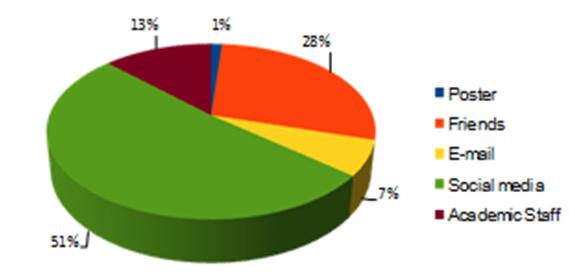 | Figure 2. Modes of publicizing the event |
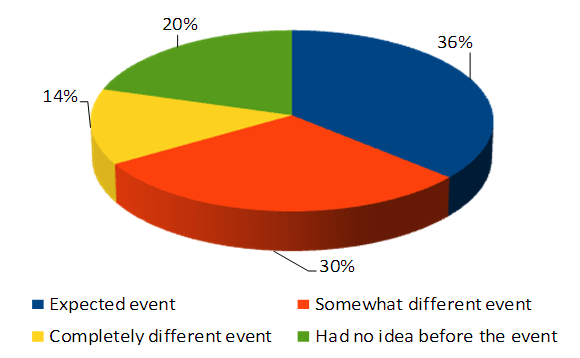 | Figure 3. Pre-judgment about the event |
 | Figure 4. Judgment of different aspects of the event |
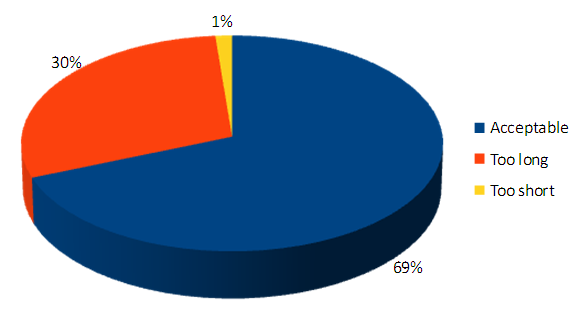 | Figure 5. Response to total time duration of the event |
 | Figure 6. Reflections on solutions after the event |
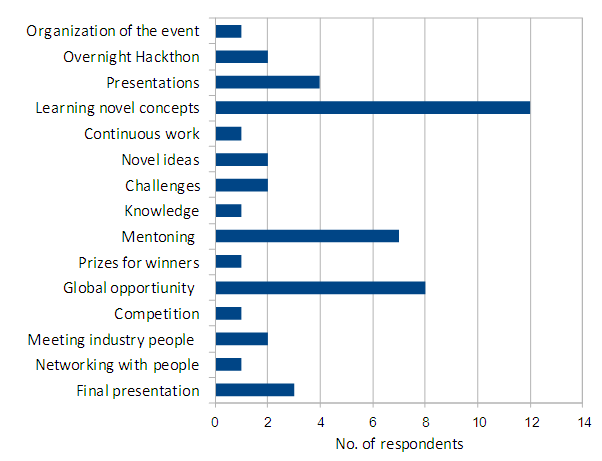 | Figure 7. Ranking of most useful aspect of the event |
 | Figure 8. Concerned aspects related to the event |
7. Discussion and Conclusions
- DigiEduHack’19 was generally found to be successfully implemented in Sri Lanka connecting several European Institutes and one other institute from the Asian region. This event provided an opportunity for the participants to enhance their competence in finding innovative solutions rapidly. This type of global hackathons also is very useful for teachers and educational policy makes to find feasible solutions to the issues in higher education in view of expanding the access to quality education for remote areas by the use digital emerging technologies. It is a good indication that majority has attended the event with the intention of creating innovative solutions with critical thinking, and with the knowledge of the purpose of a hackathon. It is natural that conducive environment should prevail with relatively short period of time during which participants aggressively investigate solutions to the issues exploring all avenues and related technologies. It is the responsibility of organizers to create such working atmosphere that helps create and maintain high level of motivation. Learning novel concepts through engaging in groups, exposure to global community and the mentoring process were ranked as most exciting aspects by the participants. The most concerned aspects of the event, according to the participants, were short time for presentations of the solutions, working up to the mid-night, long duration of the event and the non-technical facilities. Some of these factors certainly are due to non-availability of a pleasant and encouraging environment that would have deterred the motivation to see the goals realized.Despite certain drawbacks due to logistic arrangements the final conclusion was that this type of global hackathons are very encouraging and they can yield good results with global perspective and provides an opportunity to share the knowledge and experiences with the other parts of the world. The facilitation of the DigiEduHack’19 by the OUSL has contributed to inspire the academics and participants to explore further about the digital education by investigating related issues in the Sri Lankan context and finding solutions to them. The event also provided an opportunity for the educators to pinpoint the specific areas of application of digital education in Sri Lanka and as well as the areas to be focused on which speedy solutions are required for successful integration of digital education to local education system.From the respective teams’ perspectives, we have learnt that the interest of young graduates to research on new digital technologies to overcome existing problems that stand as barriers to expand the distance education, and the desire to work in teams. From the perspective of OUSL we have learnt that there is a strong need for delivery of learning content accessible through smart phones as well as the availability of expertise within participants to deal with issues that might surface in this area. These items will be incorporated into a new Master Program presently in the development within the EU Capacity Building for Higher Education EUSL-Energy3.
ACKNOWLEDGEMENTS
- Authors acknowledge EIT Climate-KIC, Aalto University and European Commission for organizing and funding this global event and the Open University of Sri Lanka for facilitating to join the event from Sri Lanka.
Appendix 1
- 1.1. Participating Institutions and Countries
 1.2. Titles of Motivational Speeches
1.2. Titles of Motivational Speeches 1.3. Proposed Solutions to the Challenges (OUSL) https://digieduhack.com/en/solutions
1.3. Proposed Solutions to the Challenges (OUSL) https://digieduhack.com/en/solutions 1.4. Evaluation Criteria for OUSL Location
1.4. Evaluation Criteria for OUSL Location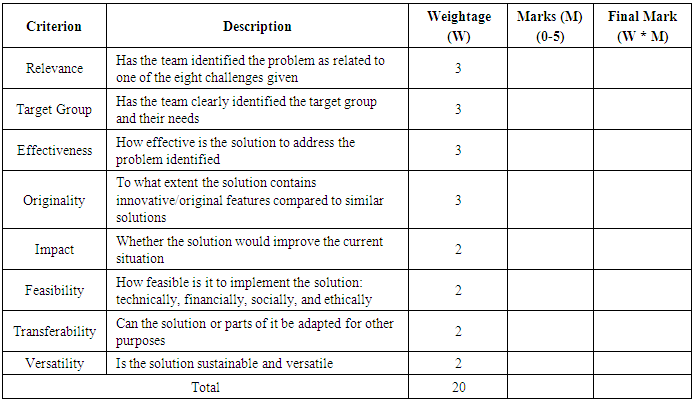 1.5. Questionnaire Administered
1.5. Questionnaire Administered 
Notes
- 1. https://digieduhack.com/en2. European knowledge and innovation community, working towards a prosperous, inclusive, climate-resilient society founded on a circular, zero-carbon economy - https://www.climate-kic.org/.3. Europe Sri Lanka Capacity Building in Energy Circular Economy Project No. 610173-EPP-1-2019-1-LK-EPPKA2-CBHE-JP.
 Abstract
Abstract Reference
Reference Full-Text PDF
Full-Text PDF Full-text HTML
Full-text HTML